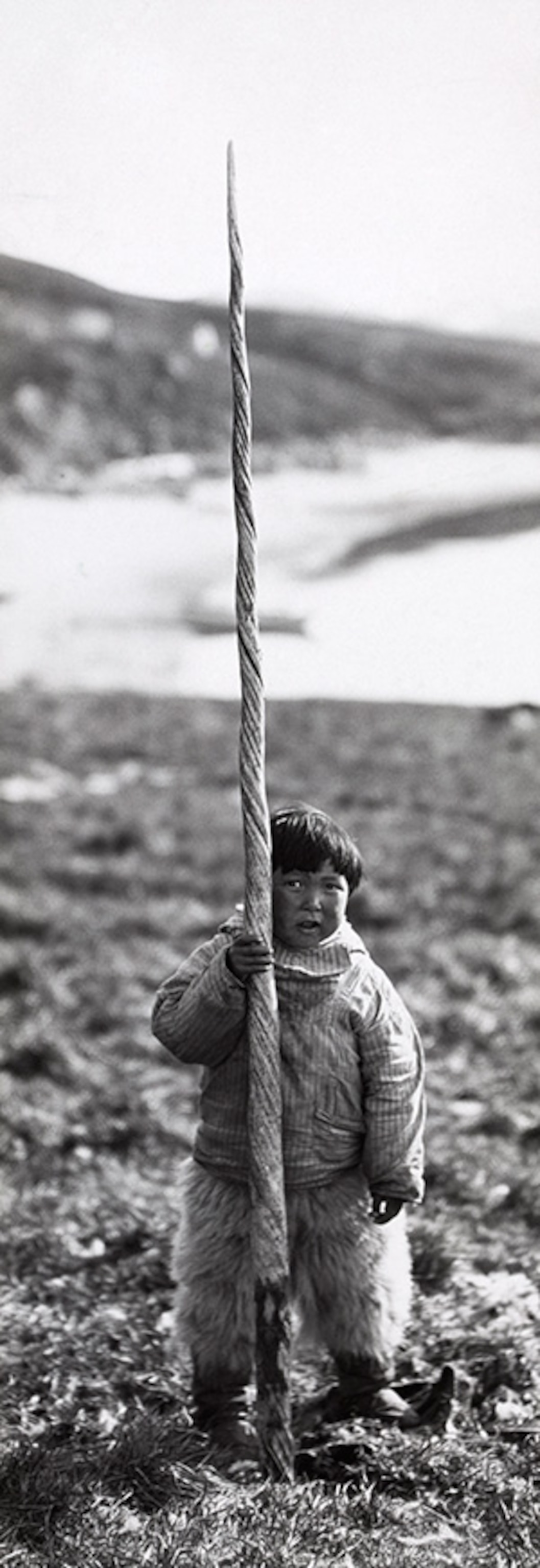In 1577, the English explorer Martin Frobisher led an expedition of 150 men to the northern reaches of Canada, in search of a passage to India and a fortune in gold. As they surveyed the islands near the coast, they came across something Frobisher could never have anticipated: a unicorn fish.
“Upon another small island here,” Frobisher wrote in his journal, “was also found a great dead fish, which, as it would seem, had been embayed with ice, and was in proportion round like to a porpoise, being about twelve foot long, and in bigness answerable, having a horn of two yards long growing out of the snout or nostrils. This horn is wreathed and straight, like in fashion to a taper made of wax, and may truly thought to be the sea-unicorn.”
When Frobisher returned to England, he presented the horn to Queen Elizabeth, who commanded that it be kept with the crown jewels.
Unicorn horns–or at least what traders claimed were unicorn horns–had circulated around Europe for centuries before Frobisher’s voyage. They were worth many times their weight in gold; Elizabeth was said to have paid 10,000 pounds for a unicorn horn, the price of a castle. Unicorn horn was in the cups that monarchs drank from, the scepters that they wielded.
The myth of the unicorn reaches back to the classical world, but the business of unicorn horn trade was sustained through the Middle Ages and the Renaissance by Vikings who killed the so-called sea unicorns in the North Atlantic, cut off their horns, and sold them at astronomical prices–never revealing their origin.
As Europeans naturalists became more familiar with the world’s animals, the myth of the unicorn faded, and it became clear that Frobisher’s sea-unicorn was actually a whale–what is known today as the narwhal. But while the source of the horn has become clear, the horn itself still inspires confusion and debate among scientists.

The horn is not a horn at all, but a tooth. The relatives of narwhals include species like beluga whales, orcas, and dolphins. They all have sets of simple, peg-like teeth in their mouths they use to catch prey. In the mouth of male narwhals, one tooth has grown to monstrous proportions, its counterpart usually growing to a much shorter length. The narwhal’s tooth is comparable to the tusks of elephants or warthogs, but doesn’t have a hint of a curve to it.
But why should a whale grow a tusk? Or, more precisely, how did such a freakish tooth evolve in this one species after its ancestors branched off from whales with ordinary teeth?
The ideas scientists have put forward over the years have been legion. The list includes–but is not limited to–an acoustic probe, a means for dumping extra heat, a rudder, an ice-picker, and a spear for battling predators or perhaps other narwhals. Most of those ideas emerged not from close observation but speculation. The narwhals live in remote Arctic fjords and the ice-strewn ocean. They do not make it easy for scientists to see them use their tusk for anything at all.
Martin Nweeia, a Connecticut dentist and a clinical instructor at the Harvard School of Dental Medicine, has been traveling to the Arctic for fourteen years to study narwhals, and, in particular, their tusks. He’s given some scientific talks about his research over the years and published some details in book chapters. But now he and a team of colleagues from Harvard, the Smithsonian, the University of Minnesota, Fisheries and Oceans Canada, and elsewhere have published a detailed account of their studies on the narwhal tusk in the Anatomical Recorda detailed account of their studies on the narwhal tusk in the Anatomical Record. They conclude that the tusk is a sense organ that lets male narwhals perceive the ocean, possibly helping them find mates or food.
Part of their argument is based on the anatomy of the tusk. Rather than being a solid hunk of bone, it’s shot through with nerves. And it appears specially adapted to bring those nerves nearly in contact with sea water. In us and in other mammals, teeth are armored in sheets of enamel. Narwals don’t have enamel on their tusks. Instead, the surface of the tusk is covered in fine channels that can bring water down into the tusk’s interior, close to the nerve endings there. And some of those nerve endings have the structure you find in nerves sensitive to pain.
To see if the narwhals used this intricate anatomy to sense their surroundings, Nweeia and his colleagues captured live narwhals off of Baffin Island and slipped a conical jacket over their tusks. The scientists then pumped water into the jacket, either with a high or a low level of salt. Electrodes that Nweeia’s team put on the skin of the narwhals measured their heart rate through the experiment, which only lasted less than half an hour per animal.
When the scientists put salt water into the tusk jacket, they recorded an average heartbeat of 60.42 beats per minute. But when they poured in fresh water, the heart beat more slowly, at 52.56 beats per minute. The difference was statistically significant, and the scientists took it to mean that the narwhals could sense the difference between salt and fresh water with their tusk alone. It’s possible that when the narwhals swim into salty water, they feel a pain akin to a toothache. It’s also possible that other nerve endings in the tusk sense other things, such as temperature or pressure.
Here is a figure that elegantly sums up the anatomy they found:

If the narwhal tusk is indeed a sensory organ, it’s only benefiting the males. Nweeia and his colleagues suggest that the males may use it to sense things that can help them win mates. They may be able to track down female narwhals by sampling the chemicals in the water, searching for the ones found where the females feed. They might even be able to sense whether females are receptive for mating from the chemicals they release. Some males might be able to use their tusk to find food for newborn calves. Males with more sensitive tusks would have better luck at reproducing than others, and that difference would drive the evolution of the wildly elongated tusk.
I got in touch with some other experts on whale anatomy to see what they thought of all this. In general, they were pretty dazzled by the data Nweeia and his colleagues have brought together.
“They have done a great job collating several hundred years of hypotheses about narwhal tusk function, and then throwing nearly every existing line of evidence at the problem,” Nick Pyenson, the curator of marine mammals of the Smithsonian Institution told me.
Joy Reidenberg, the Icahn School of Medicine anatomist whom I wrote about last year, summed up her reaction as, “WOW.” Each line of evidence they compiled could have been a separate paper, and she gave Nweeia and his colleagues high praise for combining them all into one coherent account. “It is so refreshing to see a paper where the focus is not on the least publishable unit, but rather, on a comprehensive understanding of form, function, and evolution.”

But some researchers were not persuaded by the conclusions that Nweeia and his colleagues drew from all that data. Their biggest critic was Kristin Laidre of the University of Washington. For starters, she notes that having sensitive teeth is not unique to narwhals. “When you eat ice cream, your teeth hurt, and the nerves in your teeth tell your brain you’re eating something cold,” she told me.
That’s good information to have, but it wouldn’t make sense to say that our teeth are sense organs. They evolved to let us bite and grind food.
Nweeia and his colleagues acknowledge that teeth can sense things in other species, but they argue that the narwhal tusk is doing something beyond what ordinary teeth are capable of. Laidre doesn’t think that the heartbeat readings let them reach that conclusion. “Heart rate collected 30 minutes after an animal has been put through an invasive net capture event and beached in shallow water tells you the animal is stressed, not how it reacts to various saline solutions on its tooth,” she told me.
Laidre also disputes the scenarios Nweeia and his colleagues present for how males might use their tusks for sensing. Studies on the stomach contents of narwhals have revealed that males and females feed on the same kind of prey, in the same parts of the ocean, at the same times of year. And it’s females that care for young narwhals, without any evidence that males provide any help. Females are so important for the survival of young narwhals, in fact, that Laidre has a hard time imagining males having such a sensitive organ and the females lacking it.
The notion of the tusk being a critical sensory organ, says Laidre, “remains a toothless theory with no supporting data.”
Instead, Laidre suspects male narwhals use their tusks to compete for mates. Scientists can’t watch them use their tusks as easily as they can watch elk lock antlers or fiddler crabs flip each other over with their giant claws. But they have seen male narwhals “tusking”–that is, crossing their tusks at the surface of the water. And they’ve seen females nearby when this happens, where they may be developing a preference for a particular male.
The last person I consulted about the narwhal study was not a whale expert at all, but a biologist who studies beetles. Douglas Emlen of the University of Montana studies the absurdly giant horns of rhinoceros beetles and other species. He’s taught me a lot about animal weapons in general as we’ve co-authored a textbook on evolution. (On a related note, you can pre-order his fabulous book on weapons, that’s coming out in November).
When I asked him what he thought about the debate over narwhal tusks, he pointed me to a fascinating study published by his student Erin McCullough last year with Robert Zinna of Washington State University. They took a close look at the horn of the Giant Rhinoceros Beetle from Japan. Its surface turns out to be covered with touch-sensitive hairs. Some parts of the horn are densely covered in hair, while others are sparser.

And McCullough and Zinna found a pattern to the hairs. When two male beetles prepare for battle on a tree branch, they approach each other and tap their horns together. If one is much smaller than the other, it will then back away. If they’re equally matched, they then take the conflict to the next level, and try to toss each other off the branch. It turns out that the densest patches of sensory hairs are precisely where the beetle horns make contact with the horns of their enemies.
Perhaps narwhals are the beetles of the whale world. Choosing between a sensory organ and a weapon may be a false choice. Perhaps male narwhals do go into battle, but they size up their opponents first.
Even if someone were to run with that idea, it would probably be a long time before they confirmed it–if they ever did. It’s been 437 years since Frobisher laid eyes on a dead narwhal, and it’s not that much easier today for scientists to see much more of this strange but elusive species.
[Related: “Narwhal’s Trademark Tusk Acts Like a Sensor, Scientist Says.”]
[Reference: Sensory Ability in the Narwhal Tooth Organ System, Nweeia et al, Anatomical Record 2013, in pressSensory Ability in the Narwhal Tooth Organ System, Nweeia et al, Anatomical Record 2013, in pressSensory Ability in the Narwhal Tooth Organ System, Nweeia et al, Anatomical Record 2013, in press]

